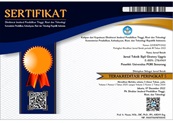ANALISIS KEHILANGAN AIR DAN EFISIENSI SALURAN (STUDI KASUS SALURAN SEKUNDER BANTUL DI PEKALONGAN)
Abstract
Keywords
Full Text:
PDFReferences
D. Mulya and Istiarto, “Perencanaan Kapasitas Embung untuk Daerah Irigasi Kaliwadas, Kabupaten Pemalang, Jawa Tengah,” Universitas Gadjah Mada, 2023. [Online]. Available: https://etd.repository.ugm.ac.id/penelitian/detail/223964
A. Ansori, A. Ariyanto, and Syahroni, “Kajian efektifitas dan efisiensi jaringan irigasi terhadap kebutuhan air pada tanaman padi (Studi kasus irigasi Kaiti Samo Kecamatan Rambah Kabupaten Rokan Hulu),” J. Mhs. Tek. Univ. Pasir Pengaraian, vol. 2, no. 3, pp. 457–470, 2014.
W. Bunganaen, R. Ramang, and L. L. M. Raya, “Efisiensi Pengaliran Jaringan Irigasi Malaka (Studi Kasus Daerah Irigasi Malaka Kiri),” J. Tek. Sipil, vol. 6, no. 1, pp. 23–32, 2017, [Online]. Available: http://nirmana.petra.ac.id/index.php/jurnal-teknik-sipil/article/view/20439
R. Wirosoedarmo, B. Rahadi, and S. I. Laksmana, “Evaluasi Efisiensi Saluran Terhadap Debit Aliran Air pada Jaringan Irigasi Purwodadi Magetan , Jawa Timur Irrigation Efficiency Evaluation to the Water Flow at the Purwodadi Irrigation,” J. Sumberd. Alam dan Lingkung., vol. 3, no. 3, pp. 16–25, 2018.
A. S. Nugraha and A. Nurhasanah, “Analisa Debit Banjir Menggunakan Metode Rating Curve (Lengkung Debit),” Junal - Univ. Bandar Lampung, 2021, [Online]. Available: http://dx.doi.org/10.31219/osf.io/5xedy
D. Krisnayanti and I. M. Udiana, “Studi Pola Lengkung Kebutuhan Air Untuk Irigasi Pada Daerah Irigasi Tilong,” J. Tek. Sipil, vol. 5, no. 1, pp. 117–126, 2016.
K. Tsuchiya, Y. Hara, and D. Thaitakoo, “Linking food and land systems for sustainable peri-urban agriculture in Bangkok Metropolitan Region,” Landsc. Urban Plan., vol. 143, pp. 192–204, 2015, doi: 10.1016/j.landurbplan.2015.07.008.
DOI: https://doi.org/10.26877/giratory.v6i1.24091
Refbacks
- There are currently no refbacks.

This work is licensed under a Creative Commons Attribution-ShareAlike 4.0 International License.
Jurnal Teknik Sipil Giratory UPGRIS
Program Studi Teknik Sipil
Fakultas Teknik dan Informatika
Universitas PGRI Semarang



